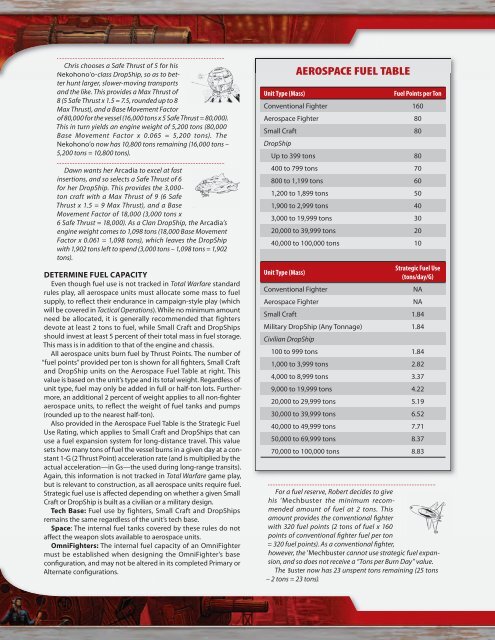the shape of things to come
the shape of things to come
the shape of things to come
You also want an ePaper? Increase the reach of your titles
YUMPU automatically turns print PDFs into web optimized ePapers that Google loves.
Chris chooses a Safe Thrust <strong>of</strong> 5 for his<br />
Nekohono’o-class DropShip, so as <strong>to</strong> better<br />
hunt larger, slower-moving transports<br />
and <strong>the</strong> like. This provides a Max Thrust <strong>of</strong><br />
8 (5 Safe Thrust x 1.5 = 7.5, rounded up <strong>to</strong> 8<br />
Max Thrust), and a Base Movement Fac<strong>to</strong>r<br />
<strong>of</strong> 80,000 for <strong>the</strong> vessel (16,000 <strong>to</strong>ns x 5 Safe Thrust = 80,000).<br />
This in turn yields an engine weight <strong>of</strong> 5,200 <strong>to</strong>ns (80,000<br />
Base Movement Fac<strong>to</strong>r x 0.065 = 5,200 <strong>to</strong>ns). The<br />
Nekohono’o now has 10,800 <strong>to</strong>ns remaining (16,000 <strong>to</strong>ns –<br />
5,200 <strong>to</strong>ns = 10,800 <strong>to</strong>ns).<br />
Dawn wants her Arcadia <strong>to</strong> excel at fast<br />
insertions, and so selects a Safe Thrust <strong>of</strong> 6<br />
for her DropShip. This provides <strong>the</strong> 3,000<strong>to</strong>n<br />
craft with a Max Thrust <strong>of</strong> 9 (6 Safe<br />
Thrust x 1.5 = 9 Max Thrust), and a Base<br />
Movement Fac<strong>to</strong>r <strong>of</strong> 18,000 (3,000 <strong>to</strong>ns x<br />
6 Safe Thrust = 18,000). As a Clan DropShip, <strong>the</strong> Arcadia’s<br />
engine weight <strong>come</strong>s <strong>to</strong> 1,098 <strong>to</strong>ns (18,000 Base Movement<br />
Fac<strong>to</strong>r x 0.061 = 1,098 <strong>to</strong>ns), which leaves <strong>the</strong> DropShip<br />
with 1,902 <strong>to</strong>ns left <strong>to</strong> spend (3,000 <strong>to</strong>ns – 1,098 <strong>to</strong>ns = 1,902<br />
<strong>to</strong>ns).<br />
DETERMINE FUEL CAPACITY<br />
Even though fuel use is not tracked in Total Warfare standard<br />
rules play, all aerospace units must allocate some mass <strong>to</strong> fuel<br />
supply, <strong>to</strong> refl ect <strong>the</strong>ir endurance in campaign-style play (which<br />
will be covered in Tactical Operations). While no minimum amount<br />
need be allocated, it is generally recommended that fighters<br />
devote at least 2 <strong>to</strong>ns <strong>to</strong> fuel, while Small Craft and DropShips<br />
should invest at least 5 percent <strong>of</strong> <strong>the</strong>ir <strong>to</strong>tal mass in fuel s<strong>to</strong>rage.<br />
This mass is in addition <strong>to</strong> that <strong>of</strong> <strong>the</strong> engine and chassis.<br />
All aerospace units burn fuel by Thrust Points. The number <strong>of</strong><br />
“fuel points” provided per <strong>to</strong>n is shown for all fi ghters, Small Craft<br />
and DropShip units on <strong>the</strong> Aerospace Fuel Table at right. This<br />
value is based on <strong>the</strong> unit’s type and its <strong>to</strong>tal weight. Regardless <strong>of</strong><br />
unit type, fuel may only be added in full or half-<strong>to</strong>n lots. Fur<strong>the</strong>rmore,<br />
an additional 2 percent <strong>of</strong> weight applies <strong>to</strong> all non-fi ghter<br />
aerospace units, <strong>to</strong> refl ect <strong>the</strong> weight <strong>of</strong> fuel tanks and pumps<br />
(rounded up <strong>to</strong> <strong>the</strong> nearest half-<strong>to</strong>n).<br />
Also provided in <strong>the</strong> Aerospace Fuel Table is <strong>the</strong> Strategic Fuel<br />
Use Rating, which applies <strong>to</strong> Small Craft and DropShips that can<br />
use a fuel expansion system for long-distance travel. This value<br />
sets how many <strong>to</strong>ns <strong>of</strong> fuel <strong>the</strong> vessel burns in a given day at a constant<br />
1-G (2 Thrust Point) acceleration rate (and is multiplied by <strong>the</strong><br />
actual acceleration—in Gs—<strong>the</strong> used during long-range transits).<br />
Again, this information is not tracked in Total Warfare game play,<br />
but is relevant <strong>to</strong> construction, as all aerospace units require fuel.<br />
Strategic fuel use is aff ected depending on whe<strong>the</strong>r a given Small<br />
Craft or DropShip is built as a civilian or a military design.<br />
Tech Base: Fuel use by fighters, Small Craft and DropShips<br />
remains <strong>the</strong> same regardless <strong>of</strong> <strong>the</strong> unit’s tech base.<br />
Space: The internal fuel tanks covered by <strong>the</strong>se rules do not<br />
aff ect <strong>the</strong> weapon slots available <strong>to</strong> aerospace units.<br />
OmniFighters: The internal fuel capacity <strong>of</strong> an OmniFighter<br />
must be established when designing <strong>the</strong> OmniFighter’s base<br />
confi guration, and may not be altered in its completed Primary or<br />
Alternate confi gurations.<br />
AEROSPACE FUEL TABLE<br />
Unit Type (Mass) Fuel Points per Ton<br />
Conventional Fighter 160<br />
Aerospace Fighter 80<br />
Small Craft<br />
DropShip<br />
80<br />
Up <strong>to</strong> 399 <strong>to</strong>ns 80<br />
400 <strong>to</strong> 799 <strong>to</strong>ns 70<br />
800 <strong>to</strong> 1,199 <strong>to</strong>ns 60<br />
1,200 <strong>to</strong> 1,899 <strong>to</strong>ns 50<br />
1,900 <strong>to</strong> 2,999 <strong>to</strong>ns 40<br />
3,000 <strong>to</strong> 19,999 <strong>to</strong>ns 30<br />
20,000 <strong>to</strong> 39,999 <strong>to</strong>ns 20<br />
40,000 <strong>to</strong> 100,000 <strong>to</strong>ns 10<br />
Unit Type (Mass)<br />
Strategic Fuel Use<br />
(<strong>to</strong>ns/day/G)<br />
Conventional Fighter NA<br />
Aerospace Fighter NA<br />
Small Craft 1.84<br />
Military DropShip (Any Tonnage)<br />
Civilian DropShip<br />
1.84<br />
100 <strong>to</strong> 999 <strong>to</strong>ns 1.84<br />
1,000 <strong>to</strong> 3,999 <strong>to</strong>ns 2.82<br />
4,000 <strong>to</strong> 8,999 <strong>to</strong>ns 3.37<br />
9,000 <strong>to</strong> 19,999 <strong>to</strong>ns 4.22<br />
20,000 <strong>to</strong> 29,999 <strong>to</strong>ns 5.19<br />
30,000 <strong>to</strong> 39,999 <strong>to</strong>ns 6.52<br />
40,000 <strong>to</strong> 49,999 <strong>to</strong>ns 7.71<br />
50,000 <strong>to</strong> 69,999 <strong>to</strong>ns 8.37<br />
70,000 <strong>to</strong> 100,000 <strong>to</strong>ns 8.83<br />
For a fuel reserve, Robert decides <strong>to</strong> give<br />
his ’Mechbuster <strong>the</strong> minimum recommended<br />
amount <strong>of</strong> fuel at 2 <strong>to</strong>ns. This<br />
amount provides <strong>the</strong> conventional fi ghter<br />
with 320 fuel points (2 <strong>to</strong>ns <strong>of</strong> fuel x 160<br />
points <strong>of</strong> conventional fi ghter fuel per <strong>to</strong>n<br />
= 320 fuel points). As a conventional fi ghter,<br />
however, <strong>the</strong> ’Mechbuster cannot use strategic fuel expansion,<br />
and so does not receive a “Tons per Burn Day” value.<br />
The Buster now has 23 unspent <strong>to</strong>ns remaining (25 <strong>to</strong>ns<br />
– 2 <strong>to</strong>ns = 23 <strong>to</strong>ns).


